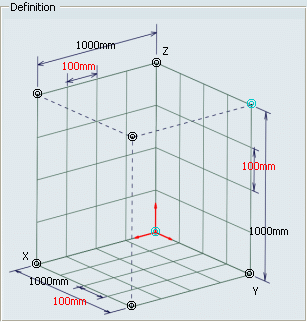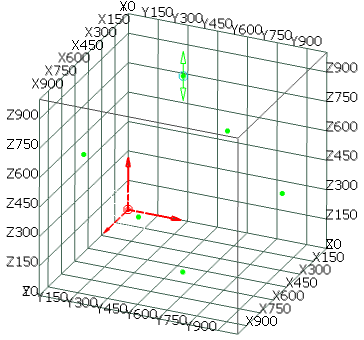Click Work on Support 3D
 in the Tools toolbar.
in the Tools toolbar.
The Work On Support 3D dialog box appears.
Part Design
default configurations do not provide this icon in the standard
toolbar. If you wish to access it, simply use the Customize
capability to add this icon to the toolbar of your choice. Otherwise,
select the
item from the menu bar.

Choose the Labels position:
-
Full Screen: labels are displayed all
around the screen
-
Bottom/Left: labels are displayed on the bottom left of the
screen
-
None:
no label is displayed
Specify the Label size value.
The label size indicates the height of the label in pixels unit.
By default, the value is set to 8 pixels.
Define the Support Type:
-
Reference: the 3D support is created according to the main
axis system.
-
Local: a local system must be specified. There can
be as many local 3D works on support as desired.
Select the Type of the visible area, that is the visualization range for each of the three grids:
- Infinite (default type): the visible area corresponds to the three infinite planes.
Note:
If selected, the Furtive grids option is automatically selected and the Support Type and Origin fields are grayed out.
- Finite: an origin point that defines the intersection of the three grids should be selected (if not, the default origin of the reference or local axis system is taken into account).

You can define which area is to be visualized from the origin point for each of the three grids. To do so, select a position among the 8 possible positions (defined by double dots as shown in the picture above).
Once you have clicked Preview, the three limited grids appear along with manipulators to resize the visible area of the grids.

Note:
If selected, the Furtive grids option is automatically cleared.
Optional: Clear the Furtive grids option
to visualize the three grids.
Note:
This option is selected by default and persistent. When selected, it lets you see the grids only when they are parallel to one of the three planes of the 3D support.
Optional: From the Grid sub-toolbar, click Grid
Featurization Switch
 to create either featurized lines or featurized planes
on the grid lines. Featurized planes are created normal
to the current grid.
to create either featurized lines or featurized planes
on the grid lines. Featurized planes are created normal
to the current grid.
Optional: From the Grid sub-toolbar, click Snap to
point  to snap the point being created onto the
nearest intersection point on the grid.
to snap the point being created onto the
nearest intersection point on the grid.
Click OK in the dialog box.
The elements (identified as Working support 3D.xxx) are added to
the specification tree under the Working supports node.
The 2D working supports belonging to the 3D working supports feature are displayed in the specification tree and are aggregated under the 3D feature. Therefore, the visualization of the three grids can be individually controlled by the Hide/Show contextual command.

Click Top View
 from the Quick View toolbar.
from the Quick View toolbar.
The active work on support is visualized and labels
are displayed on each straight line.
